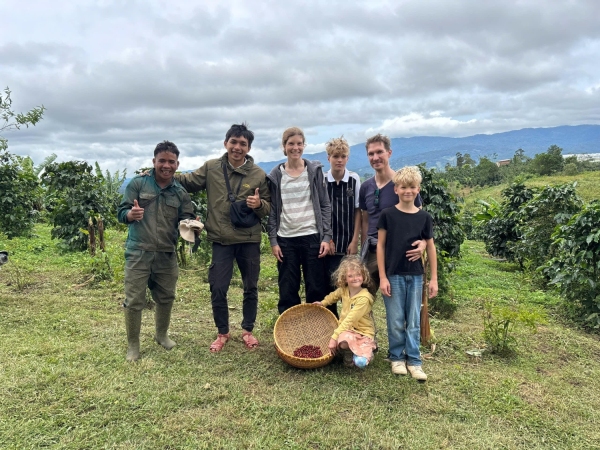
Most people think of coffee as just beans, but in reality, it’s a fruit—a cherry that holds two seeds inside. Like any fruit, its ripeness defines its flavor, aroma, and quality.
When we first started handpicking 100% ripe cherries, we immediately noticed the difference compared to conventional harvesting. The sweetness, acidity, and balance were completely transformed.\

🔗 Experience the difference of handpicked coffee: Order HuyEco Coffee
Back when I was a student, I assumed good coffee came from factories or modern labs, where experts in white coats crafted perfection like in commercials. The reality couldn’t be further from the truth.
Coffee’s true quality begins in the field, where cherries must be:
✔ Picked at peak ripeness to ensure sweetness
✔ Processed on the same day to prevent fermentation defects
✔ Dried properly to preserve the unique characteristics of the fruit
🌄 In the Da Lat highlands, the cold nights create a unique contrast—while the soul feels uplifted by the work, the body fights against the freezing temperatures. Every harvest season pushes us to overcome both environmental and logistical challenges.

🔗 Visit our farm & experience the journey: Eco-Friendly Coffee Farm Tour
If you’ve ever seen coffee being harvested, you might not realize that coffee cherries come in multiple colors, each representing different quality levels.
🌈 Ripeness Stages:
🍒 Fully ripe coffee – Deep red or purple (best for flavor)
🌳 Under-the-tree coffee – Dark red due to shade exposure
🍯 Bourbon variety – Sometimes yellow instead of red
💡 Beware:
✔ Yellow or green cherries can indicate under-ripe beans, resulting in bitterness
✔ If not carefully picked, green cherries compromise flavor


Vietnam’s coffee farms are located on sloping land, making harvesting and transport extremely demanding.
✔ Ripe cherries must be picked in multiple rounds over three months
✔ Transporting cherries by motorbike requires skill and caution
✔ Most farmers prefer quick harvesting (picking everything at once) to simplify movement
💡 Handpicking takes more effort—but it’s the only way to produce top-tier coffee.

🔗 Learn why hand-harvesting matters for quality: Sustainable Coffee Practices
Our farm was the first in the region to process and dry coffee ourselves instead of selling fresh cherries to factories. To maintain quality, we designed elevated drying racks 1 meter off the ground to:
✔ Prevent mold growth by improving airflow
✔ Ensure even drying for consistent flavor
✔ Improve processing hygiene for specialty-grade coffee
🌿 The first drying rack was rough and unstable—but it was the beginning of a long journey toward refining our craft.

🔗 Explore the handcrafted drying process: How We Process Our Coffee
After drying, coffee still contains hidden defects, requiring multiple rounds of sorting.
✔ Floating method (water sorting) removes damaged cherries
✔ Hand-sorting eliminates defective beans before roasting
✔ Machines now handle 98% of sorting, but manual selection ensures perfection


🔗 Taste the result of meticulous processing: Buy Our Coffee
Today, we have complete control over coffee production, ensuring sustainability and superior quality at every step:
🌱 Cultivation – Chemical-free, sustainable farming
☕ Harvesting – Selective handpicking for natural sweetness
🔥 Processing – Hand-sorting and drying for consistency
🥃 Roasting – Perfecting flavors through controlled heat profiles
🏡 Brewing – Bringing handcrafted coffee straight to consumers

🔗 Enjoy farm-to-cup coffee from our sustainable farm: Order Specialty Coffee
👉 Order HuyEco Coffee
Hand-picked, naturally dried, and craft-roasted coffee—made from ripe cherries only.
👉 How We Process Our Coffee
From our first handmade drying rack to water sorting—our journey to clean processing.
👉 Blog: Sustainable Coffee Farming – A Personal Journey
Why we chose to grow coffee slowly, carefully, and without compromise.
👉 Book an Eco Coffee Tour
Pick ripe cherries, learn the process, and taste the difference.
👉 Perfect Daily Grind – Why selective picking matters in specialty coffee
A deep dive into how ripeness affects flavor and quality in specialty coffee.
👉 IFOAM – Principles of Organic Agriculture
The four principles that guide organic farming worldwide.
👉 FAO – The Role of Organic Fertilizer in Soil Health
How compost and organic inputs help restore soil fertility.
Reader Comments
Newer articles
 Sustainable Coffee & Local Culture Tour in Da Lat — Arabica, Robusta & Ethical Farming
Sustainable Coffee & Local Culture Tour in Da Lat — Arabica, Robusta & Ethical Farming
 Discover Sustainable Coffee in Da Lat — A Farm-to-Cup Journey with HuyEco
Discover Sustainable Coffee in Da Lat — A Farm-to-Cup Journey with HuyEco
 Sustainable Coffee and Local Farming Realities in Da Lat HuyEc
Sustainable Coffee and Local Farming Realities in Da Lat HuyEc
 From Forest to Cup: A Personal Journey into Sustainable Coffee in Da Lat
From Forest to Cup: A Personal Journey into Sustainable Coffee in Da Lat
 Inside HuyEco: How a Coffee Huller Machine Transformed Our Coffee Production
Inside HuyEco: How a Coffee Huller Machine Transformed Our Coffee Production
 From Forest to Cup: A Farmer’s Vision for Sustainable Coffee and Local Travel in Da Lat
From Forest to Cup: A Farmer’s Vision for Sustainable Coffee and Local Travel in Da Lat
 Field Notes from Xã Lát: Rooted in Regenerative Coffee & Indigenous Farming
Field Notes from Xã Lát: Rooted in Regenerative Coffee & Indigenous Farming
 Đưng K'Nớ: Brewing Sustainable Coffee in Vietnam’s Highland Forest
Đưng K'Nớ: Brewing Sustainable Coffee in Vietnam’s Highland Forest
 Living Coffee Ecosystem in Da Lat – HuyEco’s Way of Growing
Living Coffee Ecosystem in Da Lat – HuyEco’s Way of Growing
 Nel Drip & Wabi-Sabi: Japanese Coffee Rituals at HuyEco Da Lat
Nel Drip & Wabi-Sabi: Japanese Coffee Rituals at HuyEco Da Lat